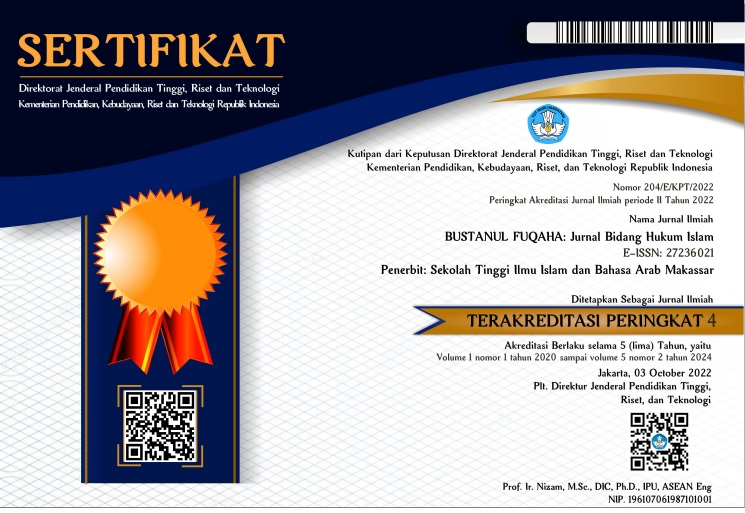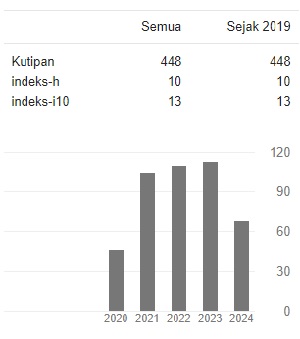Metode Penetapan Waktu Salat Menurut Dewan Syariah Wahdah Islamiyah
DOI:
https://doi.org/10.36701/bustanul.v1i1.126Keywords:
method, prayer, wahdah, astronomy, rukyatAbstract
This study aimed to identify and recognize the correct method in determining shari prayer times according to Sharia Board of Wahdah Islamiyah. The issues in this study were; First, Islamic jurisprudence and the position of the sun being the main point of reference according to the Sharia in determining the initial time for prayer; Second, the law of employing astronomy in determining the initial time for prayer; Third, the correct method in determining shari prayer times according to Sharia Board of Wahdah Islamiyah. The type used was descriptive qualitative (non-statistical) research, which focused on the study of scripts and texts, employing a normative approach (shari) with field studies in the form of interviews with related figures. The results of the study show that; first, to recognize the Islamic jurisprudence and the position of the sun as the main point of reference in determining the initial time for prayer must be understood based on the propositions in the Koran and sunnah through the interpretation of the scholars who were well-known for their credibility. Second, in determining the prayer time schedule, the main method used is the method of rukyat with the help of astronomy as a means and device, but not as a primary point of reference. In addition, the process of preparing the prayer schedule is necessarily conducted through discussions by experts of Islamic jurisprudence and astronomy, both those affiliated with Wahdah Islamiyah and experts from outside Wahdah Islamiyah who are willing to provide recommendations and suggestions.
Downloads
References
Al-Banjary, N. H. (2013). Penemu Ilmu Falak: Pandangan Kitab Suci dan Peradaban Dunia. Yogyakarta: Pustaka Ilmu.
Al-Adwi, Ahmadi. 2009. Al-qaulual-Qawam Fi Al-Salati Hasba Al-Taqwim, 2009.http://www.ahlaldeeth.com/vb/showthread.php?t=183719.html. (20 Agustus 2017).
Al-Asqalani, A. H. I. H. (2013). Terjemah Bulughul Maram. Cet.8; Solo: al-Tibyān.
Azhari, S. (2005). Ensiklopedi hisab rukyat. Pustaka Pelajar.
Bashori, M. H. (2015). Pengantar Ilmu Falak: Pedoman Lengkap Tentang Teori dan Praktik Hisab, Arah Kiblat, Waktu Salat, Awal Bulan Qamariah & Gerhana. Pustaka Al Kautsar.
Sugono, D. (2008). Kamus Besar Bahasa Indonesia Edisi Keempat. Pusat Bahasa DEPDIKNAS: Jakarta.
Departemen Agama Republik Indonesia. 2012. Al Kaffah, Al-Quran dan Terjemah, Jakarta: Sukses Publishing.
Ibnu Qudāmah Al-Maqdisī, al-Mughnī (t. Cet.; t.t.p.: al-Maktabah al-Syāmilah, t.th) [CD-ROM], al-Qāhirah: Maktabah al-Qāhirah. 1986, juz. I.
Muhammad bin Isa al-Tirmiżi, Jāmi‟ al-Tirmiżi (t.cet.,t.t.p..al-maktabah syamilah.t.th), Beirut; Ihya al-turaṡ al-arabi, Juz 1.
Muhammad bin Muhammad al-Mukhtar al-Syinqiti, al-Tasykik fi waqti al-Fajr hasba Taqwim Ummulqura tanskripsi vidio (Qanat fawaid al-Mukhtar) no.37.
Muhammad Ṣalih al-Uṡaimῑn, Syarah Ṡalaṡah Al-Uṣul, (t. Cet ; t.t.p. :Dar al Kutub al-Ilmiyah, 1424 H).
__________, Syarah Riyaḍu al-Ṣālihin (t. cet., tt: al-maktabah syamilah, t. th), riyadh : daar al-wat an li al-nasyr. 1426H, juz 3.
Muslim bin Hajjaj bin Muslim al-Naisabūr, Shahih Muslim, (t.Cet.; Beirut : Ihya al-Turaṡ, t.th) Juz 1.
Novira, N., & Ahmad, A. (2019). Tinjauan Akidah Islam Terhadap Adat Mappalili di Balla Lompoa Kelurahan Baju Bodoa Kecamatan Maros Baru Kabupaten Maros Sulawesi Selatan. NUKHBATUL'ULUM: Jurnal Bidang Kajian Islam, 5(1), 15-25.
Pemula. 2014. Makalah Hisab rukyat. http://kamakalandara.blogspot.com/2014/10/makalah-hisab-rukyat.html. (20 Agustus 2017).
Sirajuddin Qasim. 2017. Menyikapi Polemik Jadwal Waktu Salat. Makalah.
Wikipedia. Astronomi di dunia Islam pada Abad Pertengahan. https://id.wikipedia.org/wiki/Astronomi_di_dunia_Islam_pada_Abad_Pertengahan. (11 April 2020).
Wikipedia. Wahdah Islamiyah. https://id.wikipedia.org/wiki/Wahdah_Islamiyah. (10 Februari 2020).
Yunta, A. H. D. (2019). Tinjauan Hukum Pelaksanaan Salat Id di Beberapa Masjid yang Berdekatan Dalam Satu Wilayah. NUKHBATUL'ULUM: Jurnal Bidang Kajian Islam, 5(1), 54-63.
http;//sihat.kemenag.go.id/waktu-salat. (20 Agustus 2017).














